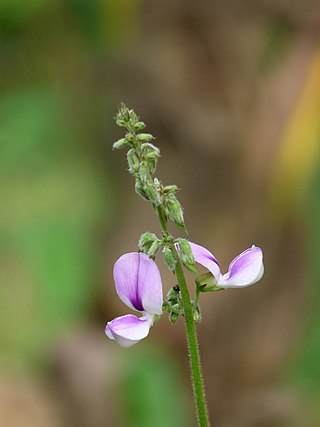
Kudzu, also called Japanese arrowroot or Chinese arrowroot, is a group of climbing, coiling, and trailing deciduous perennial vines native to much of East Asia, Southeast Asia, and some Pacific islands. It is invasive in many parts of the world, primarily North America.

The Faboideae are a subfamily of the flowering plant family Fabaceae or Leguminosae. An acceptable alternative name for the subfamily is Papilionoideae, or Papilionaceae when this group of plants is treated as a family.

Pueraria montana is a species of plant in the botanical family Fabaceae. At least three sub-species are known. It is closely related to other species in the genus Pueraria and the common name kudzu is used for all of these species and hybrids between them. The morphological differences between them are subtle, they can breed with each other, and it appears that introduced kudzu populations in the United States have ancestry from more than one of the species.

Pueraria is a genus of 15–20 species of legumes native to south, east, and southeast Asia and to New Guinea and northern Australia. The best known member is kudzu, also called Japanese arrowroot. The genus is named after 19th century Swiss botanist Marc Nicolas Puerari.
Pueraria mirifica, also known as กวาวเครือ Kwao Krua, is a plant found in northern and north eastern Thailand and Myanmar.

The plant tribe Phaseoleae is one of the subdivisions of the legume subfamily Faboideae, in the unranked NPAAA clade. This group includes many of the beans cultivated for human and animal food, most importantly from the genera Glycine, Phaseolus, and Vigna.

Asparagaceae, known as the asparagus family, is a family of flowering plants, placed in the order Asparagales of the monocots. The family name is based on the edible garden asparagus, Asparagus officinalis. This family includes both common garden plants as well as common houseplants. The garden plants include asparagus, yucca, bluebell, and hosta, and the houseplants include snake plant, corn cane, spider plant, and plumosus fern.

Daidzein is a naturally occurring compound found exclusively in soybeans and other legumes and structurally belongs to a class of compounds known as isoflavones. Daidzein and other isoflavones are produced in plants through the phenylpropanoid pathway of secondary metabolism and are used as signal carriers, and defense responses to pathogenic attacks. In humans, recent research has shown the viability of using daidzein in medicine for menopausal relief, osteoporosis, blood cholesterol, and lowering the risk of some hormone-related cancers, and heart disease. Despite the known health benefits, the use of both puerarin and daidzein is limited by their poor bioavailability and low water solubility.

Miroestrol is a phytoestrogen, a plant-derived chemical that mimics the biological activity of the hormone estrogen. Miroestrol was first reportedly isolated from the Thai herb Pueraria mirifica in 1960 and thought to be responsible for the supposed rejuvenating properties of the plant. However, more recent studies have suggested that the active ingredient may actually be the closely related chemical compound deoxymiroestrol, and the reported presence of miroestrol may only have been an artifact of the isolation procedure. When deoxymiroestrol is exposed to the oxygen in air, it is converted to miroestrol.
Arthroclianthus is a genus of flowering plants in the family Fabaceae. It belongs to the subfamily Faboideae. Its 13–19 species are all endemic to New Caledonia. Its closest relatives include Nephrodesmus, also endemic to New Caledonia, Ohwia and Hanslia.
Nephrodesmus is a genus of flowering plants in the legume family, Fabaceae. It belongs to the subfamily Faboideae. It contains four species, all endemic to New Caledonia. Its closest relatives is Arthroclianthus, also endemic to New Caledonia and their distinction has been challenged.

Daidzin is a natural organic compound in the class of phytochemicals known as isoflavones. Daidzin can be found in Chinese plant kudzu and from soybean leaves.

Puerarin, one of several known isoflavones, is found in a number of plants and herbs, such as the root of the kudzu plant.

Kudzu is an invasive plant species in the United States, introduced from Asia with devastating environmental consequences, earning it the nickname "the vine that ate the South". It has been spreading rapidly in the Southern United States, "easily outpacing the use of herbicide, spraying, and mowing, as well increasing the costs of these controls by $6 million annually". Estimates of the vine's spread vary, from the United States Forest Service's 2015 estimate of 2,500 acres per year to the Department of Agriculture's estimate of as much as 150,000 acres annually.

The tribe Desmodieae is one of the subdivisions of the plant family Fabaceae. It is composed of two subtribes, Desmodiinae and Lespedezinae. Recent phylogenetics has this tribe nested within tribe Phaseoleae.

Eminia is a genus of flowering plants in the legume family, Fabaceae. It belongs to the subfamily Faboideae. It contains the following species: It includes four species native to south-central and southern Africa, ranging from the Democratic Republic of the Congo and Tanzania to Angola, Botswana, and Mozambique.

Neustanthus is a monotypic genus of flowering plants belonging to the pea family Fabaceae and its tribe Phaseoleae. The only species is Neustanthus phaseoloides, called tropical kudzu. This species is a forage crop and cover crop used in the tropics. It is known as puero in Australia and tropical kudzu in most tropical regions.

Pueraria montana var. lobata, the East Asian arrowroot, or kudzu vine, is a perennial plant in the family Fabaceae.













